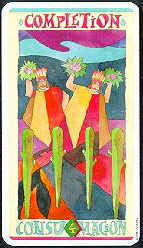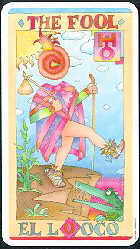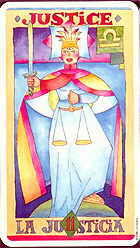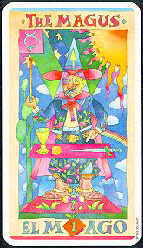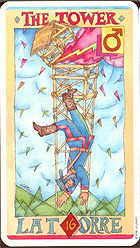Napo Tarot Deck Review
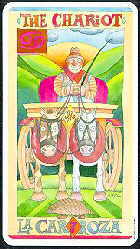
Tarot scenes in style of the Marseilles deck are rendered in blocky washed watercolour artwork in the Napo Tarot. Unusually, the scene, the border and the title on each card all are in a similar style and go well together. A nice art deck.
Deck Type: Tarot Deck Cards: 78
Creators: Betty Lopez, Napo
Publisher: US Games
Retailers
See Price at Amazon.comSee Price at Amazon.co.uk
See Price at Amazon.ca
Napo Tarot Review by Bonnie Cehovet
The "Napo Tarot" was quite a surprise for me. I bought it because it was on sale, and looked interesting - and found it to be sensational! Inspired by Argentinean myth, culture, and history, this deck closely follows the Waite-Smith tradition in card presentation. The Major Arcana titles have been retained, with the following exceptions: the Magician becomes the Magus, the High Priestess becomes the Priestess, the Hierophant becomes the Pope, Strength becomes Fortitude, and the Wheel of Fortune becomes the Wheel. The suits are Wands, Cups, Swords, and Disks (Pentacles). The court cards are Page, Knight, Queen and King.
I liked Betty Lopez's comment in her introduction, where she notes that the aboriginal mythology of Argentina skirts around mystery, destiny, and hope. What a great way to describe life! This shows strongly in the artwork, which is done in pastel coloring, using a very primitive format, into which is worked incredible esoteric symbolism. Every time you look at a card, you see something new and intriguing!
Lopez also notes the social importance of playing cards in Argentina. They were used to play card games, as well as in a divinatory capacity. In this deck, the Magus is a gaucho, living in the country, but well dressed, and well established. The Hierophant (which is retitled the Pope), is the exact figure of Old Vizcacha, a character from the book "Martin Fierro", by Jose Hernandez (which is considered a "Gaucho Bible").
As is the case with many decks, the bringing out of this deck tot he attention of the public came about as the result of a search for inner symbols. The cards came from the imagination of Betty Lopez. The drawings came from Napo, and from his understanding of the cycles of life.
The cards themselves are 2 3/4" by 4 3/4", of high quality, glossy cardstock. The back of the cards is simple, yet complex. There is a 1/4" white border around the edge, with the background coloring a bright blue. In the middle of the card four five-pointed gold stars are centered, in a diamond pattern. The LWB (Little White Book) indicates that the blue background represents the sky on a summer night. The four stars represent the Southern Cross, and the Three Marias. The cross is a symbol of the four suits in the Tarot, the four cardinal points, the four elements, and the four evangelists.
The face of the Major Arcana cards has a 1/4" white border, followed by an approximately 1/2" beige border. The card title is in English at the top of the card, and in Spanish at the bottom of the card, along with the card number. Astrological glyphs are shown in some part of each of the cards. The imagery in the deck is partly from traditional Tarot, and partly from the myths and traditions of Argentina. The Fool, for instance, has a head that is in the form of a swirl, separate from his body. The LWB says that this symbolizes the "whirlwind of ideas" within him. The Priestess, shown seated between the two pillars of the Tree of Life, with her book of knowledge in her left hand, and a flower in her right hand. Temperance is shown as a winged figure pouring liquid from one cone into another. She is surrounded by water, with green plants indicating her connection with nature. Death is shown as a white skeleton carrying a hoe in his hand - the traditional symbol of the cutting of time and the cycles of life. The Wheel shows a winged figure in the background, with a circle in front of her, made up of nine concentric circles. This is divided into four sections of colors, which recall the four elements. Shown on the circle are an angel, a lion, an eagle, and a bull, representing Air, Fire, Water, and Land (Earth) respectively. Judgment shows a cone of light surrounding an angel playing a trumpet. Below her, on the earth, a child rises from his tomb, with his parents on either side of him. The angel is a force bringing energy from heaven, while the reborn child acts as a symbol of the cycle of reincarnation. The man and woman represent the masculine and feminine principles of life.
The Minor Arcana pips carry a 1/4" white border, followed by a 1/2" beige border. A keyword is listed at the top of the card in English, and at the bottom of the card in Spanish, along with the card number. The Aces list both the card title and suit. The Court Cards list the title and suit in English at the top of the card, and in Spanish at the bottom of the card.
The LWB is text only, with no scans of any kind. The cards are listed by English title, followed by their number, Spanish title, and astrological association, meaning, situation, and related meaning. From the LWB:
Temperance
14 - La Templanza; Associated with Sagittarius
A winged figure is pouring liquids from one cone into another, and is surrounded by water. Several clouds and plants connect it with the placidity and harmony of nature. Its figure is also inscribed within a cone, which is a geometric body mystically related to energy, like a pyramid.
Meaning: A young woman, with good manners, friendly, external beauty, and harmonic balance of feelings. Spiritual elevation. Improvement in health.
Situation: Harmony, a positive and balanced situation, full of strength and optimism.
Related meaning: Together with negative Arcana cards, lack of health and harmony.
At the end of the LWB, two spreads are presented: the traditional Celtic Cross Spread, and a spread called the Draw of Four Aces. the four Aces are removed from the deck, and placed in a vertical line, in any order the Seeker wishes. They represent the following:
Wands: The Seeker's energy, work, impulse, and intuition. Cups: The Seeker's emotions. Swords: The Seeker's thoughts, health, and struggles. Disks: The Seeker's money, and his ability to achieve.
The Major Arcana is then shuffled, and one card placed to the right, and to the left, of each of the four Aces. The cards on the right represent the consciousness of the Seeker, the cards on the left represent the unconscious nature of the Seeker. Quite a powerful reading, bringing to mind work that Ruth Ann and Wald Amberstone of the Tarot School are doing with the Aces.
I am impressed with this deck, with its use of symbols, geometric form, and the ability of the author and the artist to follow the traditional path of the Tarot, as seen through the eyes of their own culture. This is a deck well worth owning.
© Bonnie Cehovet
Complete Details of Napo Tarot
Creators: Betty Lopez, NapoPublisher: US Games
Deck Type: Tarot Deck
Cards: 78
Rating: 12/20 or
Similar Decks to Napo Tarot
< Previous Deck · Back to Top · Next Deck >
Home > Tarot Reviews > Napo Tarot Review

